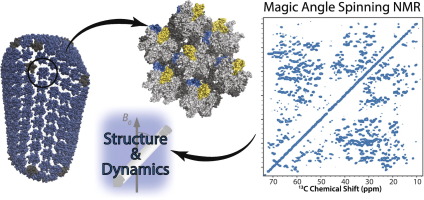Current Opinion in Colloid & Interface Science ( IF 7.9 ) Pub Date : 2017-12-19 , DOI: 10.1016/j.cocis.2017.12.005 Rupal Gupta , Tatyana Polenova

|
Since its discovery, human immunodeficiency virus (HIV) has been an intense subject of research. Several biophysical methodologies have aided towards understanding of the viral lifecycle and infectivity. Magic angle spinning (MAS) nuclear magnetic resonance (NMR) spectroscopy has played a pivotal role in several key findings, providing atomistic details about the viral particles. These contributions have been made owing to tremendous advancements in NMR instrumentation, development of novel experiments and hybrid approaches combining NMR and computational methodologies. In this review, we highlight some advances made towards characterization of structure and dynamics in HIV-1 assemblies by MAS NMR spectroscopy. These findings have established MAS NMR spectroscopy is a promising methodology to investigate large biological assemblies such as viral particles and HIV-1 protein assemblies.
中文翻译:

魔角旋转NMR光谱指导HIV-1蛋白装配体结构和动力学的原子表征
自发现以来,人类免疫缺陷病毒(HIV)一直是研究的重点。几种生物物理方法有助于理解病毒的生命周期和传染性。魔角旋转(MAS)核磁共振(NMR)光谱在几个关键发现中起着关键作用,提供了有关病毒颗粒的原子性细节。这些贡献归功于NMR仪器的巨大进步,新颖实验的发展以及结合NMR和计算方法的混合方法。在这篇综述中,我们重点介绍了通过MAS NMR光谱表征HIV-1装配体的结构和动力学方面取得的一些进展。











































 京公网安备 11010802027423号
京公网安备 11010802027423号